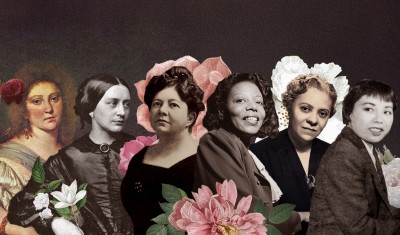International Women’s Day is March 8th. It’s a global day celebrating the social, economic, cultural, and political achievements of women. It is also a call to action for a better future, accelerating gender equality across the world.
This year’s theme is “an equal world is an enabled world.” In the spirit of celebration, we want to turn the focus on the incredible achievements of the International Sweethearts of Rhythm, the first integrated all women's band in the United States.
These women were not only powerful musicians, they rose awareness against bias, racism, and inequality within Jazz music and beyond. They fought for an enabled world. They challenged stereotypes, broadened perceptions, improved situations, and celebrated the women around them.
The Powerful Women of Jazz Music
Women have contributed throughout the many eras of jazz history, as performers, composers, songwriters and bandleaders. Yet, when you read the history books, they are ignored.
In the 2001 series on Jazz by Ken Burns, for example, there is only passing mention of female instrumentalists, despite a 19-hour run time for the entire series! Furthermore, within the 22 single-artist compilation albums that accompanied the release of the documentary series, only 3 featured women, all of them singers. In the entire history of jazz recordings, not a single female instrumentalist was deemed worthy to have an album accompany the documentary.
Women have contributed immensely to the history of jazz, unfortunately, the story is simply ignored. On top of a gender bias, a racial bias compounds the issue even more. Thankfully, trailblazing women rallied against the system and changed the narrative of jazz.
The Story of the International Sweethearts of Rhythm
From a rural school in Mississippi to centre stage at the Apollo, the story of the International Sweethearts of Rhythm is important to honour, especially leading up to International Women’s Day.
The original members of the band met in 1938 at Piney Woods Country Life School, a school for poor and African American children in Mississippi. Inspired by Ina Ray Hutton's Melodears, the school's principal and founder, Dr. Laurence C. Jones, wanted to start an all-female band at Piney Woods as a way of raising funds for the school.
In April 1941, the Piney Woods all-female jazz band, known as the International Sweethearts of Rhythm, turned professional and severed connections with Piney Woods. The “International” in their name was attributed to the different races represented in the band, including Latina, Asian, Caucasian, Black, Indian, and Puerto Rican. Anna Mae Winburn became bandleader in 1941, after resigning from her former position leading an all-male band, the Cotton Club Boys in North Omaha, Nebraska.
The International Sweethearts of Rhythm played to predominately black audiences in theatres across America, including the Apollo in Harlem, the Howard Theatre in Washington, and the Regal Theatre in Chicago. They swiftly rose to fame amongst African-American audiences, with one show at the Howard Theater show setting a new box office record of 35,000 patrons.
Throughout the 1940s the band featured some of the best female musicians of the day. Despite the level of talent in the band, they faced gender and racial discrimination. As a racially mixed band, they faced the Jim Crow laws of the South. When the band traveled in the region, all of the members ate and slept in the bus because of the segregation laws that prevented them from using restaurants and hotels.
During World War II, letter-writing campaigns from overseas African American soldiers demanded them, and in 1945 the band embarked on a six-month European tour to France and Germany, making them the first black women to travel with the USO.
The exact reasons for the band breaking up are not certain, but a great number of reasons have been doled out as to why the International Sweethearts of Rhythm began their gradual disbandment after they returned from their European tour in 1946. These include marriage, career change, tiring of always being on the road, aging, not enough money for all the effort, and managerial issues.
Their Powerful Legacy
In the early 20th century, jazz orchestras would only showcase a ‘girl singer’, believing that was the only place for women in jazz. Women rarely stood on the bandstand or wrote arrangements and compositions.
Yet, The International Sweethearts of Rhythm managed to overcome these obstacles and show that women had a place on stage. Though there's still a lot that needs to be changed in jazz, these women showed the possibilities. Unfortunately, during their time few critics took the all-female band seriously, so they were largely overlooked by the press.
They were rediscovered by academics in the '60s and '70s, but it was not jazz historians that championed them, it was the Women's Studies departments. Their story was part of a change in the discourse on the history of jazz. Because of the discrimination they experienced, few female instrumentalists were recorded, leading to a lack of remembrance. The existence of The International Sweethearts of Rhythm and other female jazz instrumentalists means that historians and musicologists have to completely change how they remember the story. They require a new framework for telling and interpreting jazz history.
On top of that, The International Sweethearts of Rhythm fought along racial lines. At a time when white people and black people in Southern America were forced to live strictly segregated lives, these women ate, slept, worked, and played together - their racial differences were a strength. Jazz Pianist and Bandleader, Earl Hines, called the International Sweethearts of Rhythm "the first freedom riders."
In 2012, the compilation album International Sweethearts of Rhythm: Hottest Women’s Band of the 1940s was selected by the Library of Congress for preservation in the National Recording Registry for being "culturally, historically, or aesthetically significant".
Listen to The Women of Jazz
Today, women hold a prominent role in the world of Jazz and continue to write, perform and sing songs that have become staples in everyday life and are pushing the jazz genre even further into greatness.
Calm Radio’s Women of Jazz channel celebrates the women that have changed the course of jazz music. It is the perfect soundtrack for International Women’s Day (and beyond).
Happy listening & Happy International Women’s Day.




